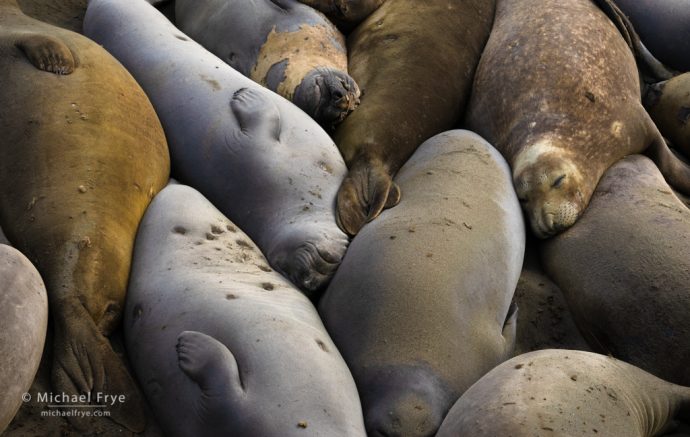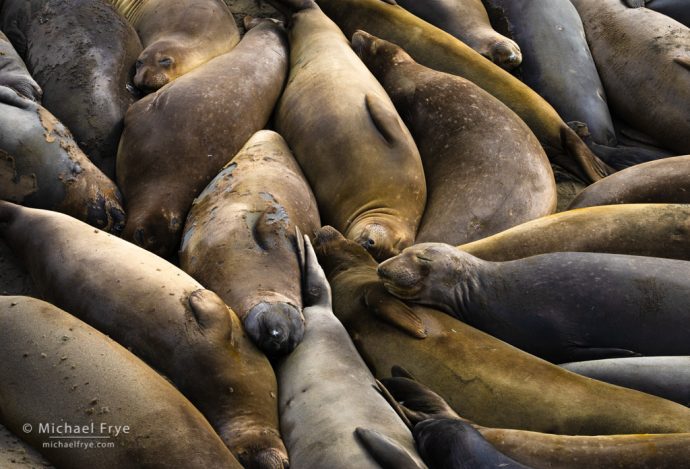
Northern elephant seals near San Simeon, CA, USA
I hope all you moms are having a nice, relaxing day!
Claudia and I found ourselves near San Simeon a few weeks ago, and decided to stop and check out the elephant seals. I became captivated by the patterns made by seals on the beach, so I got out my camera and we ended up staying for over an hour. A thin overcast created soft sidelight and backlight on the seals, which was perfect for highlighting their forms and textures – patterns of seal blubber.
These seals were all females or juveniles. The females give birth in winter, nurse their pups for about a month, then mate. Pregnant again, they head back out to sea to feed. (While searching for prey they can hold their breath for up to 100 minutes, and dive as deep as 5,000 feet below sea level.)
In April and May the females and juveniles return to the beach to molt, spending about a month ashore fasting and shedding their outer layer of hair and skin. That’s what these seals were doing; you can see patches of tan hair and skin peeling away on some of them. Then they head back out to sea to feed, with the females returning to give birth the next winter. The sub-adult males come ashore to molt in May and June, while mature males molt in July and August.
In these photos the seals look like they’re peacefully sleeping, but their rest is constantly interrupted by territorial squabbles. One seal will get in another’s space, and the two then squawk at each other, mouths agape, and sometimes lunge and try to bite each other. Several times we watched one of these 2,000-pound animals flounder across dozens of other seal bodies in an attempt to get to the other side of the pile… for some reason. Claudia’s video below shows some of the commotion.
California is a pretty amazing place.
— Michael Frye

Northern elephant seals near San Simeon, CA, USA
(If you can’t see the video, click here.)
Michael Frye is a professional photographer specializing in landscapes and nature. He is the author or principal photographer of The Photographer’s Guide to Yosemite, Yosemite Meditations, Yosemite Meditations for Women, Yosemite Meditations for Adventurers, and Digital Landscape Photography: In the Footsteps of Ansel Adams and the Great Masters. He has also written three eBooks: Light & Land: Landscapes in the Digital Darkroom, Exposure for Outdoor Photography, and Landscapes in Lightroom: The Essential Step-by-Step Guide. Michael has written numerous magazine articles on the art and technique of photography, and his images have been published in over thirty countries around the world. Michael has lived either in or near Yosemite National Park since 1983, currently residing just outside the park in Mariposa, California.









I’ve been there in January when the big bulls gather their harems as the females give birth and in June when the young bulls come to molt & spar with each other. it’s a fascinating place to hang out. The walkway above the beach gives fantastic access.
I’m glad you got to see all of that behavior. They are really fascinating to watch. In this case I was intrigued by the patterns, textures, colors, and sculptural quality of the seals, and their more sedate behavior while molting was perfect for that.
Hats off to you for being able to stand the stench for an hour. I have not been able to survive that long when I have been there. You have some great patterns to show for your efforts.
Thanks Aram. The smell wasn’t bad at all. Maybe the wind was in our favor.
Michael,
Just read about the big snowstorm in Yosimite. Can we expect some great shots when the roads open?
The roads into Yosemite Valley are always open, though they sometimes require chains. The forecast is calling for rain, not snow, in the Valley, with perhaps a dusting of snow tomorrow morning.
Great photos, Michael! I love seals. I was fortunate enough to photograph Hawaiian monk seals while living in Hawaii. It is one of the rarest marine mammals, therefore, sadly you can’t see so many of them napping together.
Thanks Gabor. Photographing the monk seals sounds cool – I’m glad you got to do that.